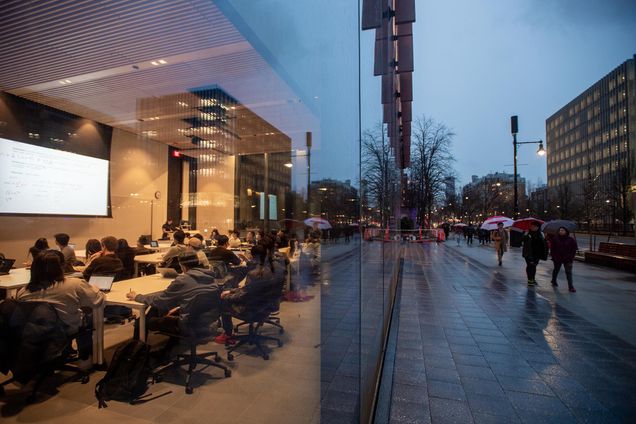BU Duan Family Center for Computing & Data Sciences
Iconic + Iconoclastic
Opened on December 8, 2022, the Boston University Duan Family Center for Computing & Data Sciences (renamed December 2024) provides an exceptional workspace. The 19-story structure features convention-bending design inside and out that makes it an iconic presence on Central Campus. That design is state of the art in every way: striking architecture, advanced resources, environmental sensitivity, and open, flexible interior spaces.
The Faculty of Computing & Data Sciences (CDS) serves as the anchor tenant, sharing the center with our Departments of Mathematics & Statistics and Computer Science, and the renowned Rafik B. Hariri Institute for Computing and Computational Science & Engineering.
A vertical campus designed for collaboration.

For all its daring exterior, the Duan Family Center for CDS's interior is what excites. More than just facilitating collaboration, the design encourages it. BU’s data science building is conceived as a vertical campus that connects a “CDS public square” on the lower floors with classrooms and labs on the middle floors, which transition seamlessly into dynamic collaborative research spaces for CDS and the Hariri Institute. The abundance of open spaces, gathering spaces, meeting spaces, and shared spaces practically assures frequent interaction among colleagues.
A literal and symbolic crossroads.

The Duan Family Center for CDS is on BU’s Central Campus: a literal crossroads connecting the physical locations of BU’s 17 schools and colleges and various centers and labs. At this spot, paths cross from arts and sciences to business, from the fine arts to communications, and from law to engineering—to name but three. Even more, the building represents a physical embodiment of Boston University’s commitment to computing and data sciences, and to the many ways they intersect with every academic discipline across our schools and colleges.
The largest green building in Boston.
BU's Duan Family Center for CDS is the University’s most sustainable and energy-efficient building to date. Here are a few of its most interesting sustainable elements:
- No fossil fuels allowed. Closed-loop geothermal wells provide heating and cooling. Even Dining Services facilities on site use electricity, instead of gas, for cooking.
- Cutting-edge exterior shades mitigate solar heat gain throughout the day and reduce glare on computer screens and whiteboards.
- The building was constructed using sealants and finishes that have few or no volatile organic compounds, to improve the air quality inside.
- The center’s “irresistible staircases,” with their natural light and compelling sculptural elements, promote physical activity and social engagement, and reduce the electricity consumed by escalators and elevators.
- The threat of rising water or sudden storm surge was a key consideration in the design of the building, given its proximity to the Charles River. So, the building is set three feet above the elevation of the Charles River dam, and five feet higher than the City of Boston’s suggested design guidelines for sea-level rise.
Explore CDS from Above
Take a virtual drone tour of the Duan Family Center for Computing & Data Sciences and explore the spaces and experiential learning places that foster innovation, exploration, and discovery at the Faculty of Computing & Data Sciences at Boston University.
Awards & Recognitions
The Duan Family Center for CDS continues to be recognized for its convention-bending interior and exterior design. Since 2019, the 19-story structure has received several awards for its striking architecture and design.
Complete List of Awards
Explore the Duan Family Center for Computing & Data Sciences
The building is like nothing you’ve ever seen. Learn more about how this remarkable project came together so that big ideas in computing and data sciences could come together.
Hours of Operation:
How the vision of an intellectual crossroads became reality.
Read the article on BU Today.
Look inside the Duan Family Center for Computing & Data Sciences—designed for collaboration and progress.
Read the article on BU Today.
